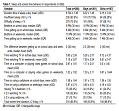Screen time activity and its impact to sleep duration of school-aged

Downloads
Background: Nowadays, massive development of technology impacts to human of all ages. One of the impacts to children is the increase of screen time activity duration. The activity correlates to children’s sleep quality, it reduces their sleep duration.
Objective: this study aims to identify factors of screen time activities and its different impact to boys and girls with age range 9-11 years old.
Methods: This study uses an observational analytic study design with a cross-sectional approach. The respondents are school-aged children aged 9-11 years old with a total of 368 respondents.
Results: This study find that children have sleeping average duration 8.704 (SD ± 1.36) h/day, and 63.9% of the children is reported to get sleep insufficiency. The screen time factor relates to sleep insufficiency of boys who spend more than 2 hours for screen time (p=0.000) and got difficulty to sleep (p=0.006). While the girls spend 2 hours or more for watching TV (p=0.013) and have difficulty of sleep (p=0.000).
Conclusion: School-aged children who have sleep insufficiency are associated with bad media habits, in a form of excessive screen time activity. It is a challenge for the parents, children, and nurses to be aware of good media habit importance.Authors retain copyright and grant the journal right of first publication with the work simultaneously licensed under a Creative Commons Attribution-NonCommercial 4.0 International License that allows others to share the work with an acknowledgement of the work's authorship and initial publication in this journal.
Authors are able to enter into separate, additional contractual arrangements for the non-exclusive distribution of the journal's published version of the work (e.g., post it to an institutional repository or publish it in a book), with an acknowledgement of its initial publication in this journal.
Authors are permitted and encouraged to post their work online (e.g., in institutional repositories or on their website) prior to and during the submission process, as it can lead to productive exchanges, as well as earlier and greater citation of published work (See The Effect of Open Access).

This work is licensed under a Creative Commons Attribution-NonCommercial 4.0 International License.











